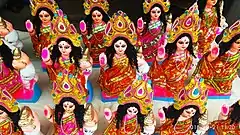Sharad Purnima
Sharad Purnima (also known as Kumara Purnima, Kojagari Purnima, Navanna Purnima,[1] Kojagrat Purnima[2] or Kaumudi Purnima[2]) is a religious festival celebrated on the full moon day of the Hindu lunar month of Ashvin (September to October), marking the end of the monsoon season.[3] The full moon night is celebrated in different ways in various cultural regions across South Asia.
| Sharad Purnima | |
|---|---|
 Idols of Kojagori Lakshmi, an avatar of goddess Lakshmi worshipped on this day | |
| Also called | Kumara Purnima, Kojagari Purnima, Navanna Purnima, Kojagrat Purnima or Kaumudi Purnima |
| Observed by | Hindus |
| Celebrations | Worshipping, offering flowers and dishes to deities, dancing |
| Date | Ashvin māsa Purnima tithi |
| Frequency | Annual |
On this day, many Hindu divine pairs like Radha Krishna, Shiva Parvati and Lakshmi Narayana are worshipped along with the Chandra, the moon deity, and are offered flowers and kheer (sweet dish made of rice and milk).[3] Deities in temples are usually dressed in white color signifying the brightness of moon. Many people observe full day fasting on this night.
Significance

Sharad Purnima celebrates the night that the Raaslila (a circular dance) was performed between Radha Krishna and the gopis (milkmaids) of Braj.[4][5] To participate in this divine raas, Shiva took the form of Gopeshwar mahadev. Vivid descriptions of this night are given in Brahma Purana, Skanda Purana, Brahma Vaivarta Purana and the Linga Purana. It is also believed that, on this full moon night, Goddess Lakshmi descends on the earth to watch the actions of human beings.[6]
Kojagari Purnima concerns the observance of the Kojagara Vrata. People perform this Vrata under the moonlight after fasting for the day. Lakshmi, the Hindu Goddess of wealth, is significantly worshipped on this day as it is believed to be her birthday.[7] Indra, the God of rain, along with his elephant Airavata is also worshipped.
Celebrations
This day is celebrated differently in various regions of India, Bangladesh and Nepal.
India
In Bengal and Assam, the night is known as Kojagari Purnima. Kojagari translate to "who is awake" in Bengali. It is believed that goddess Laxmi visits people's houses on this night and checks whether they are staying awake or not and then blesses them if they are awake.[6]
In many parts of the Gujarat, garba dance is performed in the presence of moonlight.[8]

In northern and central states of India, such as Uttar Pradesh, Bihar, Jharkhand, Madhya Pradesh and Chhattisgarh, kheer is prepared during the night and kept under the moonlight in an open roofed space throughout the night. The kheer is then eaten as a prasad on the next day. It is believed that on this night, amrit (elixir of gods according to Hinduism) is dripped from the Moon, which is collected in the kheer.[9] Also, goddess Laxmi is worshipped on this night.[10][11]
In Mithila region of Bihar, special celebration occurs in the house of newly married groom. Groom's family distribute betel and Makhana gifted from bride family to their relatives & neighbours.[12][13]
In Odisha, on this day unmarried women keep fast with the popular belief of getting their suitable groom (kumara). Unmarried girls worship the moon on the occasion of this festival.The puja starts in the early morning when the moon sets with new dress. A kula (made of bamboo strips) is used during the puja. The Kula is filled with Rice puffs, sugarcane, betel leaf, betel nut, cucumber, coconuts, and seven other fruits such as apple, banana etc. And in the evening they worship the full moon again. In the evening they break their fast by preparing a dish containing the fried paddy of the morning along with the fruits, curd, and jaggery to offer the moon god before the 'tulsi' plant. After this maidens play games and sing songs under the light of the full moon.
Nepal
In Nepal, the day is known as Kojagrat Purnima and it concludes the 15–day Dashain festival celebrations.[2] Kojagrat translates to 'who is awake' in Nepali. Similar to the traditions of eastern India, Nepalese Hindus wake up all night offering reverence to goddess Laxmi.[14] It is also the last day to receive the Dashain tika from ones relatives.[15]
Valmiki Jayanti
This day is also known as Valmiki Jayanti or the birth anniversary of Valmiki, who composed the Ramayana.[16][17]
See also
References
- Maharashtra State Gazetteers: Ahmednagar. Director of Government Printing, Stationery and Publications, Maharashtra State. 1976. p. 282.
- "आज कोजाग्रत पूर्णिमा, दशैंको समापन गरिँदै". Online Khabar (in Nepali). Retrieved 8 October 2022.
- Melton, J. Gordon (13 September 2011). Religious Celebrations: An Encyclopedia of Holidays, Festivals, Solemn Observances, and Spiritual Commemorations. ABC-CLIO. p. 798. ISBN 978-1-59884-205-0.
- Ambalal, Amit; Krishna, Kalyan; Bachrach, Emilia; Lyons, Tryna; Shah, Anita (1 January 2015). Gates of the Lord: The Tradition of Krishna Paintings. Yale University Press. p. 116. ISBN 978-0-300-21472-7.
- Lochtefeld, James G. (2002). The Illustrated Encyclopedia of Hinduism (1st ed.). The Rosen Publishing Group, Inc. p. 567.
- "Sharad Purnima 2022 date, time: Kojagiri Lakshmi Puja tithi, mahurat, vrat rituals". DNA India. Retrieved 8 October 2022.
- "Sharad Purnima 2017: Laxmi Puja or Kojagiri Purnima Date(Tithi), Significance and Bhog Rituals". NDTV.com. 5 October 2017.
but the Laxmi Puja observed on Sharad Purnima is believed to be one of the most significant ones. It is performed on the full moon day in the month of Ashwin in Hindu lunar calendar. Believed to be the birthday of goddess Lakshmi, it is also celebrated as Kunar Purnima or Kojagari Purnima - the harvest festival signifying the end of the monsoon season.
- शरद पूर्णिमा पर खेला गरबा, भगवान को लगाया खीर का भोग. Dainik Bhaskar (in Hindi).
- "Sharad Purnima 2022 Date: जानें शरद पूर्णिमा में रात भर खुले आसमान के नीचे क्यों रखी जाती है खीर". Times Now Navbharat (in Hindi). Retrieved 8 October 2022.
- "Kojagara Puja 2022: Vrat Date & Time, Importance, Pooja Vidhi". Edudwar. Retrieved 9 October 2022.
- "Kojagari Puja 2022: कल है कोजागरी पूजा, जानें मां लक्ष्मी के पूजन का मुहूर्त और महत्व". Dainik Jagran (in Hindi). Retrieved 8 October 2022.
- "आज है मिथिलांचल का लोकपर्व कोजागरा, माता लक्ष्मी की जरूर करें आराधना". ETV Bharat News. Retrieved 9 October 2022.
- "शरद पूर्णिमा आज, बन रहा है गजकेसरी का शुभ योग". Hindustan (in Hindi). Retrieved 9 October 2022.
- "सकियो दसैँ, महालक्ष्मीको आराधना गरी मनाइयो कोजाग्रत पूर्णिमा". Naya Patrika (in Nepali). Retrieved 8 October 2022.
- "आज कोजाग्रत पूर्णिमा, गर्नुहोस् यी काम". Farakdhar || Nepal's Online Magazine (in Nepali). Retrieved 8 October 2022.
- Lochtefeld, James G. (2002). The Illustrated Encyclopedia of Hinduism: N-Z. Rosen. p. 736. ISBN 978-0-8239-3180-4.
- Sharma, Mahima (9 October 2022). "Valmiki 2022 Jayanti: Date, Significance and Celebration". The Times of India. Retrieved 9 October 2022.
